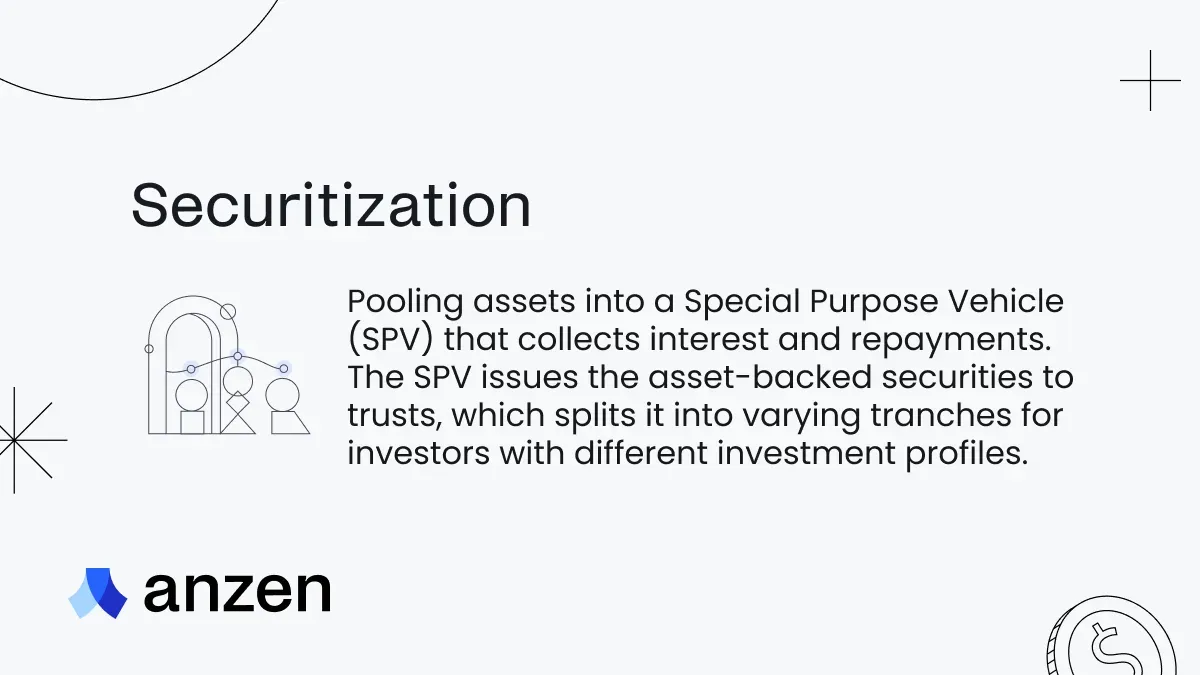· 3 min read
What are Asset-Backed Securities?
Asset-backed securities (ABS) are a type of security that is collateralized by a pool of assets
Asset-Backed Securities: Unlocking Alternative Yields
Asset-backed securities (ABS) have become an integral part of the global financial market, offering investors access to alternative yield-generating assets. In this primer, we explore the concept of asset-backed securities, their structure, and the benefits they provide to both issuers and investors. By understanding the fundamentals of ABS you can better navigate the dynamic investment instrument.
 Asset-Backed Securities are financial instruments that derive their value from a pool of underlying assets.
Asset-Backed Securities are financial instruments that derive their value from a pool of underlying assets.
What are Asset-Backed Securities?
Asset-backed securities are financial instruments that derive their value from a pool of underlying assets. These assets can range from mortgages, auto loans, credit card receivables, student loans, and more. They usually generate cashflow as a form of debt repayment. The cash flows generated by these underlying assets serve as the basis for the returns received by ABS investors.
Structure of Asset-Backed Securities:
- Pooling of Assets: The issuer of asset-backed securities pools together a diverse portfolio of underlying assets with similar characteristics. This aggregation allows for risk diversification and the creation of a larger investable unit.
- Securitization: The pooled assets are transferred to a special purpose vehicle (SPV), which holds and manages the assets separate from the issuer’s balance sheet (usually a bank). The SPV issues the asset-backed securities, backed by the cash flows generated by the underlying assets, to trusts, which splits it into varying tranches for investors with different investment profiles.
 Securitization: Pooling assets into a Special Purpose Vehicle that collects interest and repayments.
Securitization: Pooling assets into a Special Purpose Vehicle that collects interest and repayments.
- Tranches: ABS are typically divided into different tranches, each with its own risk and return profile. Tranches are created by structuring the cash flows from the underlying assets in a specific priority order. Senior tranches have the first claim on the cash flows and provide lower returns but higher credit quality, while junior tranches offer higher potential returns but carry higher risk.
Benefits of Asset-Backed Securities:
- Risk Diversification: ABS provide investors with an opportunity to diversify their portfolios by gaining exposure to a wide range of underlying assets. This diversification helps mitigate the risk associated with investing in a single asset class or industry.
- Enhanced Liquidity: Asset-backed securities offer a level of liquidity that can be superior to holding the underlying assets directly. Investors can buy or sell ABS on secondary markets, providing greater flexibility in managing their investment positions. Tokenized asset backed securities allow for even greater liquidity and flexibility.
- Yield Generation: ABS often provide attractive yields due to the underlying assets’ cash flows. Investors can benefit from regular income streams, making asset-backed securities a potential income-generating component of their investment portfolios.
- Credit Quality: Asset-backed securities can offer different credit ratings based on the quality of the underlying assets and the tranches investors choose. This allows investors to tailor their investments to their risk tolerance and return objectives.
Asset-backed securities offer an investment mechanism for transforming diverse income-generating assets into investable securities. By pooling assets and structuring cash flows, ABS provide investors with the opportunity to diversify risk, generate attractive yields, and tailor their investments based on credit quality preferences. Understanding the structure and benefits of asset-backed securities can assist individuals in making informed investment decisions, leveraging the potential offered by these versatile financial instruments.